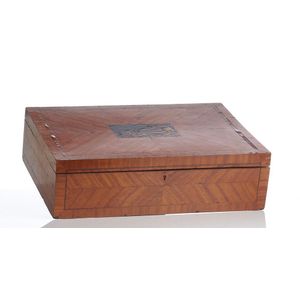19th Century English Satinwood Sewing Compendium with Chinoiserie Decor
An English satinwood sewing compendium, 19th century, the quarter veneered and crossbanded lid with a central lacquered panel decorative with a chinoiserie garden pavilion scene, opening to reveal a twelve-sectional fitted interior enclosing a storage compartment, 11 cm high, 37.5 cm wide, 25 cm deep.
You must be a subscriber, and be logged in to view price and dealer details.
Subscribe Now to view actual auction price for this item
When you subscribe, you have the option of setting the currency in which to display prices to $Au, $US, $NZ or Stg.
This item has been sold, and the description, image and price are for reference purposes only.
- Quarter Veneer - In preparation for production of quarter-sawn veneer, the log is first quartered, meaning it's cut into four equal quarters. Each quarter of the log is then cut radially, resulting in boards with annual growth rings at approximately 90 degrees to the face of the board. Veneer Cutting: These boards are then sliced into thin veneer sheets using a veneer slicer. Quarter-sawn wood is known for its unique and attractive appearance and the growth rings have a distinctive figuring often referred to as ray fleck or medullary ray.
Quarter-sawn veneer is commonly used in furniture making. The unique grain pattern adds aesthetic appeal to pieces like cabinets, tables, and chairs. Decorative Panels: It is also used in the production of decorative panels for interior applications, such as wall panelling, doors, and trim. Some musical instrument makers use quarter-sawn veneer for the back and sides of instruments like guitars, providing both visual appeal and stability.
The distinctive grain pattern adds a unique and desirable look to finished products. Quarter-sawn wood, and consequently quarter-sawn veneer, can be more expensive than other types of wood due to the cutting process - Chinoiserie - Furniture and decorative items decorated in imitation of a Western interpretation of the Chinese style. The Chinoiserie style first became popular in the late 17th century, though there were frequent revivals, notably by Chippendale (hence 'Chinese Chippendale') during the Regency period, and the Anglo-Japanese style in the second half of the 19th century.
The ubiquitous 'willow pattern' is the most common 'Chinese' theme used in porcelain, while on furniture the Chinoiserie style usually has black or red painted and lacquered decoration, though the hallmark of the furniture style is the use of fretwork in geometrical patterns, pagodas and other decorative forms.
Japonaiseries, as the name implies, are motifs in imitation of the Japanese taste.
See also "Chinese Chippendale". - Satinwood - Satinwood is a dense pale gold coloured timber that was imported into Britain in the second half of the 18th century, and early 19th centuries from the East Indies and the West Indies. The name derives from the satin-like surface sheen when the timber is polished.
It was used in the solid, as a veneer and in inlays. As well as furniture, satinwood was used for making musical instruments, barometers, boxes and clocks.
It will usually be found on only the very best quality objects, presumably because of of its cost at the time. - Compendium - A compendium is usually a wooden box that has several compartments and drawers for storing the various items. A stationery compendium would be used for storing and organizing various personal or business items including documents, business cards, passports, and other items that need to be organized and easily accessible. It is typically a wooden box t
A compendium for correspondence would usually have pockets for holding different sizes of envelopes, and sometimes may have a built-in address book or a calendar. It can also have a pen loop or holder, and sometimes a calculator.A compendium for games would usually have pockets for holding game pieces, cards and sometimes rule books. It can also have a space for a chess or checkers board.A sewing compendium would have compartments for thimbles, bobbins, needles etc.
This item has been included into following indexes:
